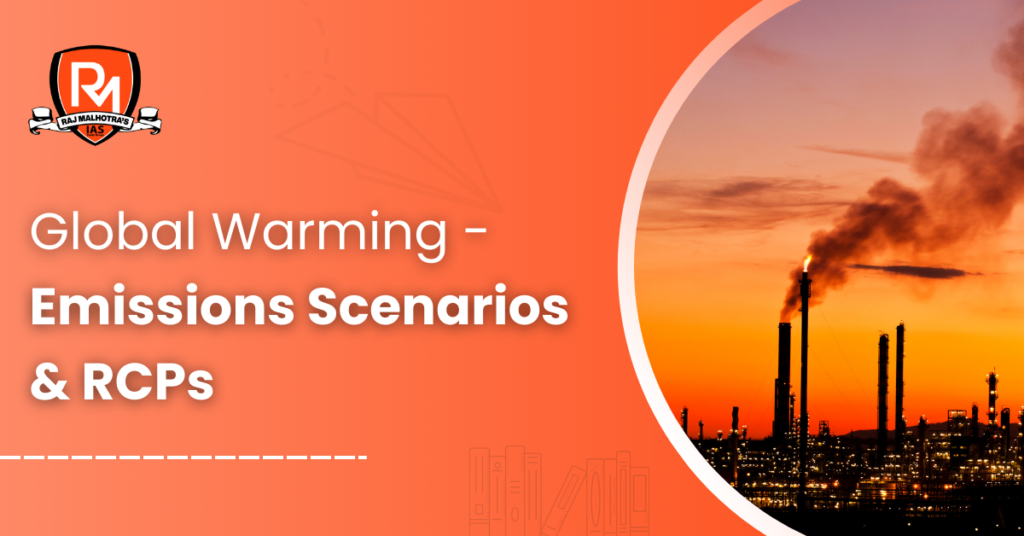Everyday climate changes due to global Warming, Emissions Scenarios & RCPs. We must know about such things not only as UPSC aspirants but also as human beings. Whenever we take a class at Raj IAS Academy, students ask how we prepare daily current affairs for UPSC. Every teacher at Raj IAS Academy ensures you know the trending and current essential topics. Today, we will be sharing one of the most important topics, Global Warming – Emissions Scenarios & RCPs, in the easiest way.
It’s essential to understand the words used in climate talks. We often hear about emission scenarios, representative concentration pathways, and total radiative forcing. But there’s more to it than just these terms. This blog wants to explain these ideas better and show how nature and humans affect global warming.
The Earth’s Heat Budget:
Understanding how the Earth stays warm is critical to understanding climate. It’s like balancing sunlight coming in with heat going out. However, this balance must be fixed when we add greenhouse gases like carbon dioxide, methane, and water vapour, which need fixing. It’s called the greenhouse effect. These gases trap heat, making the planet warmer. So, while it’s normal for Earth to have some greenhouse gases, too much can cause problems like global warming.
Understanding Emission Scenarios:
Scientists use emission scenarios to guess how much greenhouse gas we’ll produce from human activities. These guesses help climate models predict how much the Earth will warm up. Representative concentration pathways (RCPs) show different paths for greenhouse gas levels. These paths affect total radiative forcing, which measures how much heat the Earth keeps. So, by understanding emission scenarios and RCPs, we can better predict and understand global warming.
Natural Factors in Global Warming:
Apart from human actions, some natural factors play a significant role in making the Earth warmer. Milankovitch Cycles is one of them. They change how the Earth moves around the sun, affecting how much sunlight we get. Also, changes in ocean currents called thermohaline circulation, can spread heat differently in the oceans, worsening global warming. Understanding these natural factors helps us see the bigger picture of why the Earth is heating up.
Effects of Melting Ice and Volcanoes:
When ice melts because of global warming, it changes how much heat the Earth reflects, so it absorbs more heat. Also, when volcanoes erupt, like the recent one near Tonga underwater, they release water vapour and other gases into the air. This makes the greenhouse effect worse, trapping even more heat. So, melting ice and volcanic eruptions both make the Earth warmer.
Human Actions Beyond Emission Scenarios:
Besides direct pollution, human activities also affect climate in other ways. For example, as ocean waters warm up, they release stored carbon dioxide, adding to the problem. Also, when stressed forests release carbon dioxide during photorespiration, global warming worsens. Beyond emitting gases, these actions are essential when considering how humans impact the climate.
Tackling Climate Change: Taking Action Now
Climate change is a big problem that needs quick solutions. While emission scenarios are helpful, they only sometimes consider all the essential factors. We must use various methods to solve this, like reducing emissions, protecting nature, and working together worldwide. By doing this, we can tackle climate change more smartly.
Check out this report by the UN.
Conclusion: Taking Action for Our Planet
Preparing for daily news for UPSC means understanding both natural and human impacts on climate change. Realizing the problem’s size urges us to act now to protect our planet. Working together to raise awareness and adopt sustainable practices is vital. Among the many answers to the common questions, such as how to prepare daily current affairs for UPSC and many more, one thing remains the same: aspirants must be mindful of what and how they study. With Raj IAS Academy, we help you analyze your studies effectively.






